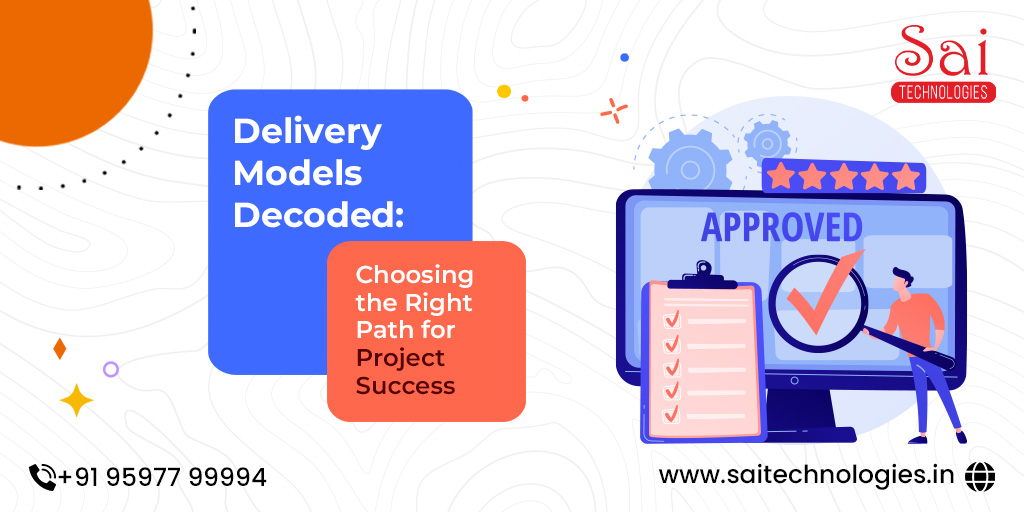Delivery Models Decoded
Choosing the Right Path for Project Success

Sai Technologies
25 March 2024
introduction:
- In the world of project management, choosing the right delivery model can have a huge impact on the success or failure of a project. From traditional waterfall methodologies to agile frameworks and everything in between, the options are vast. However, it is important for project managers to understand the nuances of each delivery model to make informed decisions that align with project goals and requirements. This comprehensive guide examines different delivery models and deciphers their complexities, benefits, and potential drawbacks to help you choose the right path to a successful project.
Understand the deployment model
- Before delving into specific delivery models, it is important to understand the concept of delivery models and their importance in project management. This chapter provides an overview of delivery models and highlights their role in project execution, resource allocation, and stakeholder collaboration. We'll explore the basic principles underlying delivery models and explain how they impact your project planning and execution strategy.
Waterfall Model
- The waterfall model is one of the oldest and most traditional delivery models in project management. This chapter analyzes the waterfall model and considers a sequential approach to project execution. Describes each stage of the waterfall model, including requirements gathering, design, implementation, testing, and deployment. We also highlight the advantages and limitations of the waterfall model and the best scenarios for project implementation.
Agile Methodology
- Agile methodologies are growing in popularity as the demand for flexibility and adaptability in project management increases. This chapter explores various agile frameworks such as Scrum, Kanban, and Lean, which provide an iterative and incremental approach to project delivery. Learn about the core principles of agile methodologies, including collaboration with customers, rapid iteration, and continuous improvement. We also explore the benefits of agile methodologies in managing changing requirements and improving team productivity.
- In many cases, a project's requirements may not perfectly align with a waterfall or agile approach. This chapter describes a hybrid delivery model that combines elements of both traditional and agile methods to meet the needs of specific projects. Let's look at an example of a hybrid model: B. Describe a hybrid of Agile and Waterfall and consider how it provides flexibility while maintaining structure for project delivery. It also provides guidance on how to effectively design and implement hybrid delivery models.
Choosing the right deployment model
- Choosing the right delivery model for your project requires careful consideration of various factors such as project scope, schedule, budget, and team dynamics. This chapter outlines a systematic approach to selecting the appropriate deployment model based on your project requirements and constraints. Discuss important considerations such as project complexity, stakeholder expectations, and team capabilities. It also provides a decision-making framework and practical tips for evaluating and selecting the best delivery model for your project.
Case Study
- To illustrate the practical application of different delivery models, this chapter presents real case studies demonstrating successful project implementations. We examine a variety of projects from a variety of industries, including software development, construction, and marketing, and analyze how different delivery models contributed to their success. By examining these case studies, readers can gain valuable insight into the strengths and limitations of different delivery models in different contexts.
Best Practices and Pitfalls to Avoid
- This final chapter summarizes key best practices for implementing effective delivery models and project success. We'll focus on common pitfalls to avoid, including: B. Poor communication with stakeholders, unrealistic expectations, and scope expansion. We also provide recommendations for ongoing monitoring and adjustments to ensure your project is aligned with your evolving needs and business goals.
Conclusion:
- Choosing the right deployment model is an important decision that can have a significant impact on the outcome of your project. Understanding the complexities of different delivery models and their impact allows project managers to make informed decisions and optimize project success. Whether it's the structured approach of a waterfall model, the flexibility of an agile methodology, or a hybrid approach tailored to the needs of a particular project, choosing the right delivery model depends on your project's requirements, constraints, and team. Dynamics must be carefully considered. With this comprehensive guide, we hope to help project managers navigate complex delivery models and chart a path to project success.

